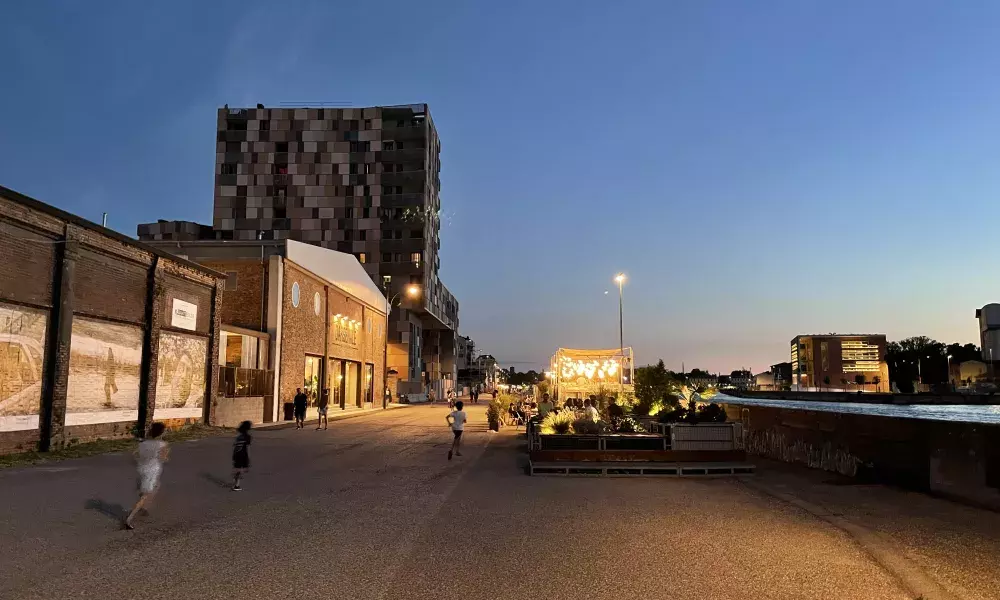
1 Executive summary
Digitalisation and digital tools are at the core of the DARE project. Unlike in many smart city initiatives, the focus in Ravenna is on the empowerment of residents and users of the Darsena area, characterised by a potential to improve the level of digital literacy. DARE aims to achieve this objective through participation and the collective creation of shared narrative of the neighbourhood.
After consolidating the partnership and developing the project’s workflow in the first year, the project’s second year focused mainly on unfolding all the participatory activities. The partnership organised a series of storylabs workshops conceived to bring together people in the four target groups (elderly, students and youngsters, entrepreneurs, public servants) to share stories of the Darsena and explore personal relationships to digital technology. These events were complemented by a series of trainings designed to build new capacities among DARE’s key target groups. In order to generate collaborative dynamics and build new competences among the Darsena’s public a series of role-playing games and specialised financial trainings were organised. A series of festive events in the form of guided tours and theatre performances placed the Darsena into the centre of attention among the Ravennati. Furthermore, Darsena residents and Ravenna citizens also shared their perceptions of quality of life and its dimensions, helping the creation of a “quality of life scoreboard” to evaluate the impact of the urban regeneration process.
At a more strategic level, DARE partners carried out an exploration of practices, projects and policies that exist in the territory and that help identify the main themes, ideas and concerns that the Ravennati have projected onto Darsena. The findings of this mapping serve as a basis to define, through a co-design process, the area’s future development scenarios.
Besides participation, empowerment in DARE also relies on available and accessible information. A key element of DARE is the collection of data and knowledge of various types, in order to create awareness of the Darsena’s transformation and support collective action as well as public decision-making. In order to generate data on a diversity of phenomena as well as to enable digital interaction in the public spaces of the Darsena, a number of sensors and smart objects have been installed.
This year, DARE went public with the launching of its digital platform. Darsena Ravenna Approdo Comune was conceived as an interface to inform the Ravennati about events and actions, share stories about the neighbourhood and collect materials from partners and the broader DARE community. The role of the platform, DARE’s principal tool of storytelling, is to support the development of a shared narrative for the Darsena and to provide a participatory space where residents and users of the area can create a common perspective for the area.
With all these processes and mechanisms in place, DARE is ready to open its next chapter. This chapter starts with an open call for projects to regenerate the Darsena, and continues by a co-design process, working towards developing a collective vision for the area’s future and towards inventing ways to implement this vision. With DARE’s digital space available, partners can also start building the pieces of their narrative.
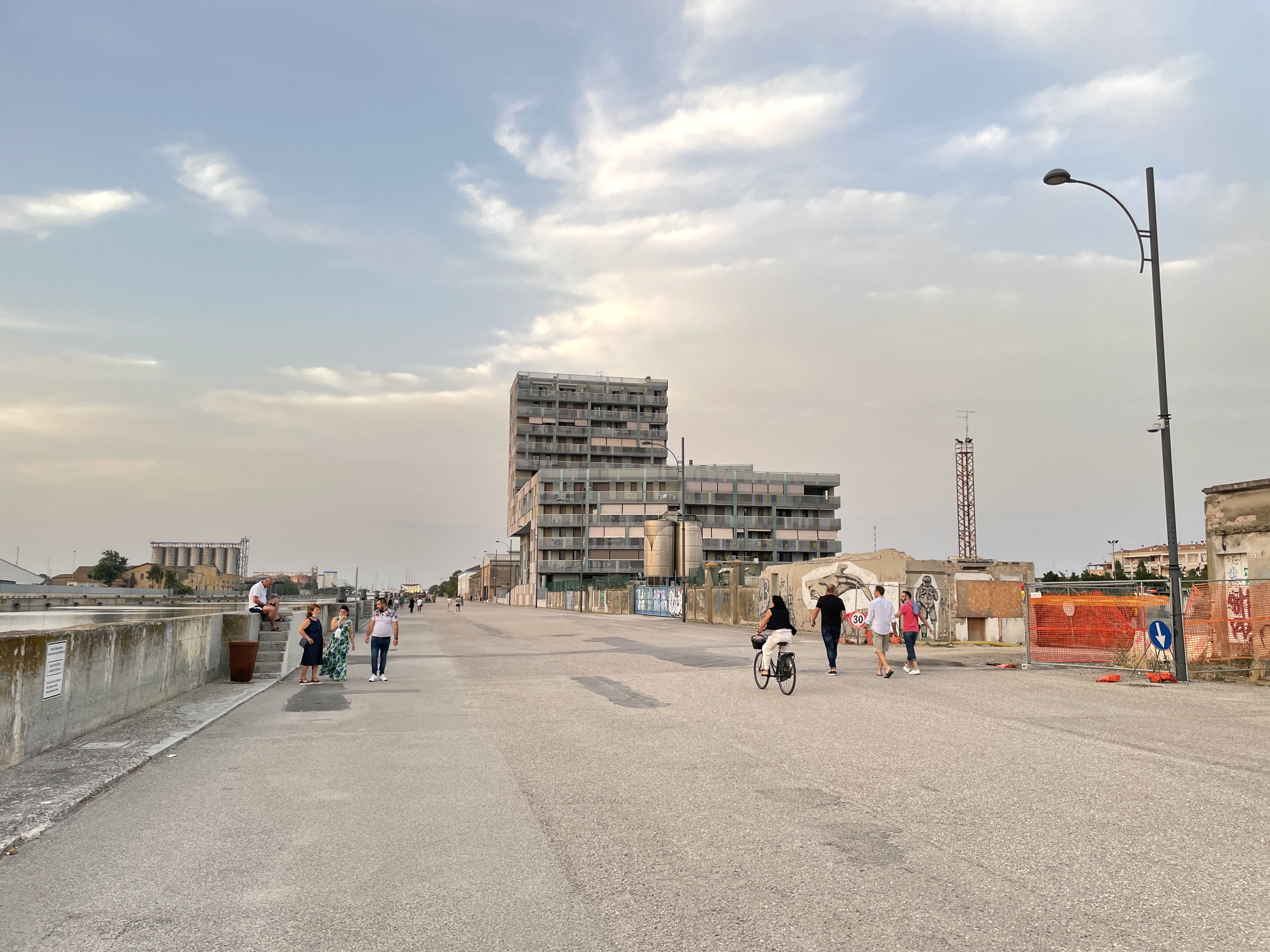
2 Project implementation process
The DARE project’s complex architecture implies that while its activities are building on each other, there are several parallel threads of actions taking place at the same time. While many of the project’s activities were delayed or disrupted by Covid-19 lockdowns, others could develop mainly according to the original plans or were boosted by the forced digital transition.
Besides Covid-19 and the corresponding lockdowns, another event that had a significant impact on the DARE project were the 2021 local elections taking place in October. Acknowledging the difficulties of organising public events during the campaign period, some activities, including the launch of the call for projects for the Darsena, were postponed to the post-election period. According to the consortium’s plans, this allows to start an important phase of the project with the needed support from both the mayor and the city council established by then.
2.1 Participatory activities and trainings
The project’s participatory activities were largely interrupted by the successive waves of lockdowns. The storylabs, workshops conceived to bring together people in the four target groups (elderly, students and youngsters, entrepreneurs, public servants) to share stories of the Darsena and explore personal relationships to digital technology, did take place offline and online, but were less participated than anticipated. The community-building aspect of the storylabs was therefore compromised but other activities were implemented to recover this aspect of the project. The storylabs were complemented by a series of trainings designed by several partners, involving the project’s Digital Facilitation Team. These trainings included civic journalism sessions to help volunteers write content about the Darsena.
In order to build collaborative dynamics among the Darsena’s public and help develop new competences among DARE’s broader community, a series of role-playing games were organised. Empaville, brought to the partnership by BiPart, is a simulation of a participatory process where participants impersonate different characters and propose ideas for an area. These ideas are then collected and weaved into joint projects, to be voted for through BiPart’s e-democracy platform. This simulation of developing projects for the Darsena was complemented by a series of financial training sessions, organised by the European Crowdfunding Network, a DARE partner, in the framework of the “month of financial education.” Besides these games, a series of guided tours and theatrical walks were organised to help the broader public explore the various faces of the Darsena.

2.2 Knowledge and data collection
A key element of DARE is the collection of data and knowledge of various types, in order to create awareness of the Darsena’s transformation and support collective action as well as public decision-making.
Despite delays caused by Covid-19 and the resulting supply chain crisis, the project could proceed with the installation of most digital infrastructure elements in the Darsena. A great variety of sensors and smart cameras have been installed in the area, to supply DARE’s data management platform with data on a diversity of phenomena, including meteorological status and pollution. A number of smart objects, including benches with Wi-Fi connection and electric chargers have been installed in strategic points of the Darsena. To facilitate hybrid (offline and online) interaction with the project, a number of “totems” or digital screens have been placed in the Darsena area that give users access to the Approdo Comune platform and all its content.
Besides gathering data, DARE is also engaged with building on existing knowledge and ideas about the Darsena. Therefore, a mapping process was designed and implemented by the Process Organisers Team, composed of DARE partners. They carried out an exploration of practices, projects and policies that exist in the territory and that help identify the main themes, ideas and concerns that the Ravennati have projected onto Darsena and that serve as a basis for the urban regeneration of the area. The goal of this process was to transform the mapping of the territory into planning perspectives and develop three possible scenarios for the area’s evolution. These scenarios will be refined during a co-planning operation with local stakeholders in the next phase of the project, defining three tactics with an integrated value that could affect the territory and fit the community’s needs.

2.3 Storytelling and narration
One of DARE’s most important objectives is to develop a shared narrative for the Darsena area with the participation of many different voices. DARE’s principal tool to crowdsource and showcase stories and memories of the area is the digital platform Darsena Ravenna Approdo Comune. The platform was conceived with the help of contributions most DARE partners and its visual identity was created as a result of a process of dialogue. Since the launch of the platform, darsenaravenna.it has become the major digital interface to inform the Ravennati about events and upcoming phases of DARE as well as to collect materials from partners and the broader DARE community, and to share stories about the neighbourhood. DARE’s storytelling is coordinated by the DARE Redazione, an editorial team involving all project partners, deciding about long-term strategies as well as the daily operation of the platform.
Telling the stories of the Darsena is supported by a series of digital instruments. Among these, storymaps help organising audio-visual and textual materials around maps, spatialising stories and audio-visual data. The storymaps collected in the Darsena Living Archive (DA.LI.A) help create narratives of the Darsena through the Candiano Canal’s story, cinema, street art or many other aspects. With the help of contributions with audio-visual materials by citizens, the Bologna University’s FrameLab has developed ten storymaps, offering residents an important channel for participating in the creation of the area’s collective memory.
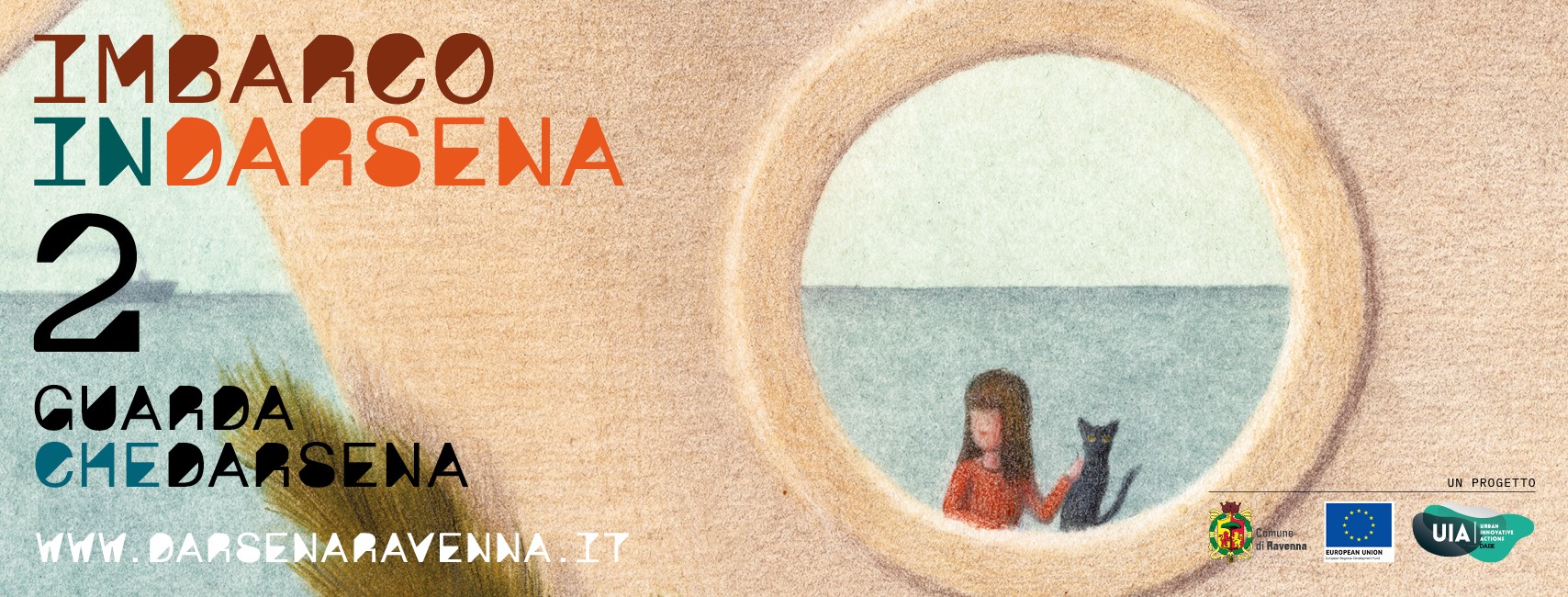
3 Challenges
3.1 Leadership
The DARE project is impacted by three levels of leadership: political, project and process.
At the political level, there has been an active involvement of the three municipal councilors involved in the project. While not having a single reference person among politicians for the project sometimes makes the process more complicated, the project’s transversality makes it naturally connected to various areas within the Municipality. Making good use of the councilors in advancing the project therefore requires the continuous sharing of information among different departments and municipal areas.
The October elections, while slowing the DARE’s implementation to not interfere with the political campaigns, brought continuity for the project: the Mayor was re-elected together with a significant part of the City Council, therefore ensuring continuous support to the project. Beyond political leadership within the City Council, DARE partners also reached out to the Emilia-Romagna Region to develop support for the project within the regional administration and to discuss the project’s place in the 2021-2027 funding period.
“Being a project of experimentation and innovation, DARE’s actions sometimes precede political instruction. The right approach by politicians is to observe and support the project without having to co-guide it. This is a very positive role in such an innovative dynamic.” Emanuela Medeghini
At the project level, the collaborating partners face the challenge of diversity in approaches and backgrounds. Although the consortium is formed by local partners, it is very heterogeneous. It consists of innovative start-ups, associations, research centres, universities and design agencies, besides the municipal departments; all of them bring along a different language, working method, specialisations and degrees of experience and knowledge in dealing within the European project framework. Therefore, coordination among the partners has required a significant effort to understand the different ways of working, to build workflows that are comprehensible to all partners and to align communication among them. Leadership at the project level plays a crucial role in this coordination: the Ravenna Municipality together with the consultant Saveria Teston act as a point of reference in this.
Leadership at the process level is a key challenge for the project. The administrative frameworks of Italian municipalities do not support long-term processes. On the one hand, the timeframes of municipalities are connected to the political cycles and this does not create a good context for building partnerships or engaging consultancies: expertise are defined within well-defined contracts and are limited by the principle of rotation, therefore it is difficult to engage consultants and external partners for longer periods. On the other hand, while municipalities create long-term strategic plans, their programming is limited to three years, which does not create the conditions for coherent long-term public action.
“Our objective was to build a process leadership disconnected from the municipality-client logic by establishing various coordination teams like the Process Organisers’ Team and DARE Redazione and conceived a multidisciplinary and transversal work connecting different sectors of public action.” Emanuela Medeghini
3.2 Public procurement
The public procurement processes of DARE confirmed some of the initial expectations and fears of the partnership. On one hand, the Covid-19 situation caused significant turmoil not only in the community activities of the project, but also in the procurement processes. Especially in the case of technological installations, disruptions in the global supply chains caused both an increase in costs and delays justified by the global context.
When you go looking for innovation and quality, it is not easy to use an evaluation grid. This is the problem: how can I evaluate the ability to accompany an innovative process when I have to give competition scores? Emanuela Medeghini
On the other hand, the lack of suitable contractual procedures for consultants created difficulties in the process of hiring people for intellectual and strategic support of the project. Public contracts can be created for services, supplies and the purchase of goods, and there are clear criteria grids for different kinds of services, like in architecture and urbanism, for example. However, for new roles that an innovative project like DARE needs, it is difficult to define the right set of criteria, weights and skills to rely on during the selection process. The usual criteria grid used in municipalities always risks giving priority to companies that have important curricula on paper and know how to manage competitions; instead of professionals or small companies that are not used to participating in large competitions. It is similar in technological innovation where there might be many unforeseen elements in the development process, traditional competitions reward larger companies that can offer a greater discount, and thus the price and the company’s CV prevails over the product. Therefore, within an innovation process, public procurement often behaves as a rigid box that does not help the process. Moreover, EU procurement rules are even stricter than Italian ones: even below a certain cost threshold, they require three offers by three operators, and in some fields it is simply too difficult to find three different persons or organisations to consult.
3.3 Participative approach for co-implementation
Ravenna has a strong tradition of participation and citizen engagement to build on. The city has activated many paths to involve citizens, but these paths have mostly concerned the definition of broad strategies, so they have always been moments of conversation, comparison and sharing aimed at defining general principles. In the DARE project, the aim of the Municipality of Ravenna is to cultivate the culture of collaboration aimed precisely at developing projects together: creating new synergies and having different subjects to work together in a co-design process.
“If we want to create a co-design path, this implies that our partners need to develop more skills and awareness. This is the path we are trying to build with role-playing games and with the call for projects. And in these new dynamics, we would also like to involve people beyond the usual stakeholders.” Emanuela Medeghini
To go beyond the regular groups and individuals who have a particular interest in the specific participation processes, the administration realised that it has to work hard to reach out to a broader network of people who, by default, do not see themselves as capable or willing to contribute. While the Darsena population has been already addressed through public institutions in the neighbourhood like the House of Cultures, the Youth Centre, incubator house Almagià and the public housing units managed by the housing organisation ACER, the municipality also aims at reaching out to the broader Ravenna population who could develop specific interests in the Darsena. For this process, the Municipality has identified a variety of target groups to engage with: children, elderly, entrepreneurs, youngsters, students and public servants. The participatory trajectory developed to reach out to these groups aims at engaging them in participating at the calls and invitations opened by DARE, even by going around in town and knocking on everyone’s door.
The participation of “unusual suspects” is therefore one of the key challenges of the DARE project. Another one is to create a collective narrative for the area, both in the physical and the digital realms. The DARE project’s digital platform Darsena Ravenna Approdo Comune aims to be a container of many different stories about the area and the open call for photographic material and family videos about the Darsena is part of DARE’s engagement and identity creation effort.
Besides many other aspects of DARE, Covid-19 and the subsequent lockdowns had an especially strong impact on participation. An example for this is the series of storylabs, participatory events conceived to create a dialogue with different target groups about the Darsena and technology. With the restrictions and fear of contagion, participation at the storylabs were limited and with the lack of physical encounters an important basis was missing for the digital participation processes. In contrast with the storylabs, the training sessions – with a more defined trajectory – had the desired participation. Here the effort of reaching out to specific interlocutors through the municipality’s contacts (schools, businesses, professional associations, universities) worked well.
“The activities of mapping, listening and talking with stakeholders also aimed at identifying who is already there, who is and who could become active.” Emanuela Medeghini
Some of the most successful ways to engage the DARE’s community was to reach out to the Ravennati and ask for their input and contributions to the neighbourhood’s narrative. The association Sguardi in Camera, collecting photos and videos about the Darsena, began working with the Teatro delle Albe and other associations on community theatre sessions focusing on the theme of narration. Besides the theatrical format, this collective narration process will also take place online in the frame of Darsena Voice. Ideas contributing to the construction of a shared narrative about the Darsena area also had an impact on the municipality’s approach to public services: inspired by the DARE consortium’s work, the new municipal library will be an experiment going beyond the traditional library genre: it will be a centre of the neighbourhood narrative, a place to document the stories of the area’s residents and users.
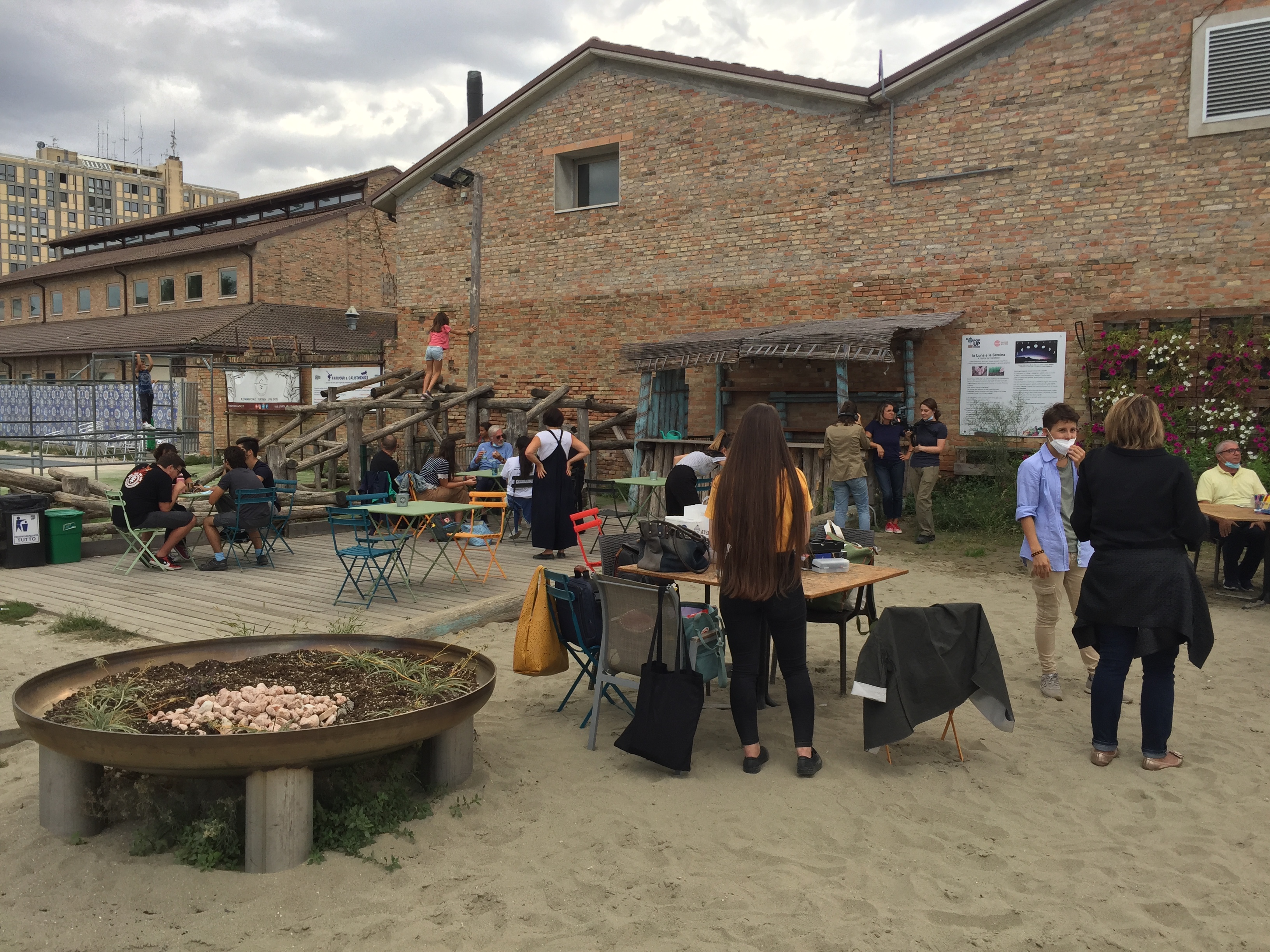
3.4 Municipal services - cross-departmental & integrated management
DARE is well-known across the whole municipality and each office brings its own contribution. The two municipal departments directly involved in the project are European Policies and Information Systems. The European Policies Department acts as the veritable engine of the project, however, the pilot actions engage all sectors of the municipality. As the different actions within DARE actually involve all departments, the combined leadership of different councillors and heads of departments can be considered a success.
DARE involves a transversal approach within the municipality and while there have been many efforts to establish this approach, there is still room for improvement. For instance, when new competences or skills are needed for the project, it is always the management team that reaches out to the respective departments: the exchange of information between different areas of the municipality does not happen spontaneously. In order to improve this collaboration it is necessary to insist, create transversal groups and make groups learn on how to better engage and work together.
3.5 Monitoring & evaluation
To create a suitable monitoring and evaluation framework, a long and hard work has been done by the partnership focusing on indicators. This required the joint definition of the key dimensions of DARE’s work to be monitored and evaluated. With the help of partners with different backgrounds, it was important to invent mechanisms to connect the data collected with indicators defined and the identified impact of the project’s actions.
“It was a complex task to work on the set of indicators with our partners because this involves putting together many different skills. We use a multidisciplinary vision of the regeneration process and we need to have a common understanding of what the relevant dimensions are.” Emanuela Medeghini
It is important to identify which are the relevant data for the development of the pilot actions, and which are the ones important to describe the cause-effect connections needed for the evaluation. A data census has been created, with all the data available within the municipality. This census has served as a basis for selecting the data that is useful and relevant for the data management system of DARE. This selection was supported by a juridical-technological analysis, focusing on the delicate juridical issues of the selected datasets like privacy as well as data treatment issues. Based on this analysis, a designated working group is created inside the municipality: the “data hunters” will specifically look for the needed data, if already available or if it is necessary to research, looking for opportunities to cross datasets without the violation of privacy laws, in the spirit of “respectful data.”
To this process adds the issue of visualising data, the editorial and design aspects of defining the best ways in which selected data can be presented and demonstrated on DARE’s digital platform. These are connected to the communicational aspects of what are the set of indicators and actions that will make the DARE process readable to a broader audience as well as the juridical aspects of who can read what kind of data.
DARE also has the potential to profoundly change the way the Ravenna Municipality uses and manages its data. While the perspective of creating open data is not motivating enough for different public sectors, if the data can be used for concrete actions, it might change the way data is collected and managed within different offices. With more data-conscious work in the different departments, the municipality’s data is to be merged in a communal platform to make data more accessible, readable and useful for everyone.
“We want to go beyond open data. Open data means that the administration collects data and makes it available to citizens in the form of tables that citizens can use for their own purposes. In contrast with this, in DARE, we would like to have these data tell something also to the non-expert citizens, by making them legible from a graphical viewpoint. It was originally not conceived as part of the project but it has become clear that besides digital education, we also need to work on collaboration and data literacy.” Emanuela Medeghini
3.6 Communication with target beneficiaries and users
DARE’s communication objective is not creating a strong city brand by closing the identity of a neighbourhood, even if this could make the area more attractive to some. On the contrary, the objective is to open a narrative path through which a collective identity can be created with the participation of various stories and narratives. The visual identity of the project, visible in all communications of DARE and its web platform, is also the result of a complex dialogue.
DARE’s main communication task therefore is to reach the broadest spectrum possible of the Ravennati, to inform them about DARE and involve them in the project. To communicate and promote DARE’s activities to a broader public, the partnership makes use of a variety of tools: newspaper, social media, word of mouth, mailing list, and now the platform “Approdo Comune,” trying to combine and mix them.
However, two years of the pandemic has distorted this effort and made DARE’s communication especially laborious because people were already overloaded with digital communication. Furthermore, for most part of this period, public restrictions related to Covid-19 did not allow any public events or other types of activities that could have catalysed participation. With the launch of Darsena Ravenna Approdo Comune, the web platform should become the main communication interface between the project’s activities and the public, therefore the challenge is to get people on the platform and have them use it in a regular manner. It is, however, a complex communication task to make a web platform part of the Ravennati’s everyday life.
“We know how to invite people to an event, for a course, for an activity or a project; but inviting people to use a portal is more difficult to communicate.” Emanuela Medeghini
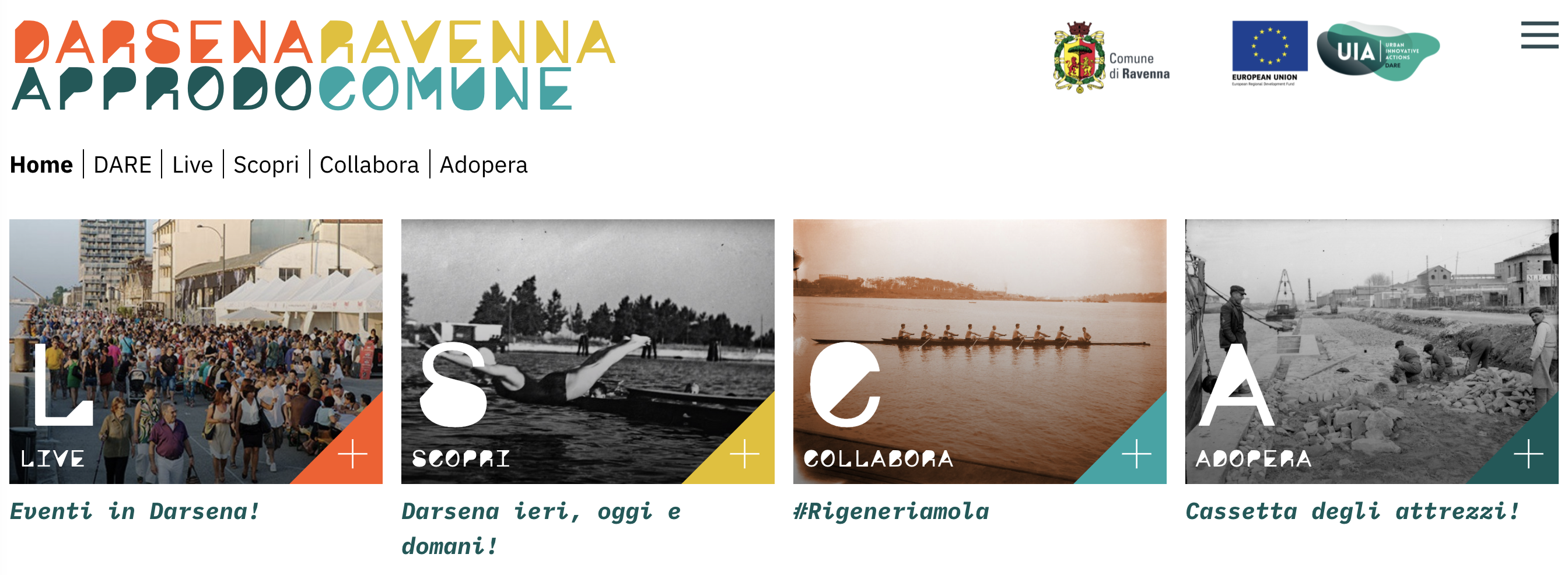
3.7 Scaling up
Since the beginning of the project, there is a clear sense of how the Darsena can serve as a prototype for other neighbourhoods and cities, and how the methodology and tools employed here can help in scaling up or multiplying the impact of DARE. While many elements of DARE are clearly transferable to other contexts, it is also an important task for the consortium partners to understand how to build on DARE’s results in their own practice and how these results can also open new opportunities for the consortium and the neighbourhood.
An occasion to test the opportunities of the consortium to upscale its methodologies was brought by a national call on the quality of housing that coincided with the establishment of the DARE partnership. The DARE consortium created a proposal for this call, testing if the workflow and governance model created in DARE could make a difference in building a proposal of this kind, thus transferring the working modalities of DARE to connected fields and multiplying its impact. The proposal, including a co-creation trajectory, an open call and negotiations with the public housing organisation, led to many ideas also enriching DARE, ranging from a census of spaces to be regenerated in the Darsena area to proposals to create new green areas and playgrounds.

4 Conclusions and lessons learnt
By the second year, the DARE partnership has been consolidated with its collaboration mechanisms and workflow established. As a result of a series of calls and public events, the broader community of the Darsena has also gradually acquainted with the project’s objectives and collaboration opportunities. With a well-designed trajectory both building up expectations and developing competences in the community, DARE has proven to be a coherent process that so far keeps its promise about participation, inclusion and empowerment.
While some of DARE’s activities, including public events, workshops and the installation of new equipment have been disrupted or delayed by the Covid-19 pandemic, the subsequent lockdowns and the related supply chain crisis, the partnership invented a variety of hybrid processes and formats that allowed adaptation to changing circumstances. By moving some events online and making up for the workshops cancelled or compromised by the pandemic, DARE managed to maintain its promise of participation and the engagement and enthusiasm of its broader community.
DARE’s next phase is about building the knowledge generated and the competences built, and working towards defining a set of regeneration activities for the Darsena. With high stakes on the table, this phase will open with a call for projects for the regeneration of the Darsena before employing a series of direct democracy tools to select the right interventions for the area. Once having a regeneration plan, DARE events will explore financial and real estate development opportunities to implement the selected visions.
DARE’s added value has been increasingly recognised both in Ravenna and beyond. With the re-election of Ravenna’s mayor and city council majority in October 2021, the political support to DARE is continued, giving momentum to DARE’s next phase. In the same month, DARE was presented at the European Week of Regions and Cities as an innovative practice, exploring the themes of intelligent cities and digital citizenship, and paving the way for more inclusive, empowering digital strategies of urban regeneration across Europe.
About this resource
The Urban Innovative Actions (UIA) is a European Union initiative that provided funding to urban areas across Europe to test new and unproven solutions to urban challenges. The initiative had a total ERDF budget of €372 million for 2014-2020.
Similar content




